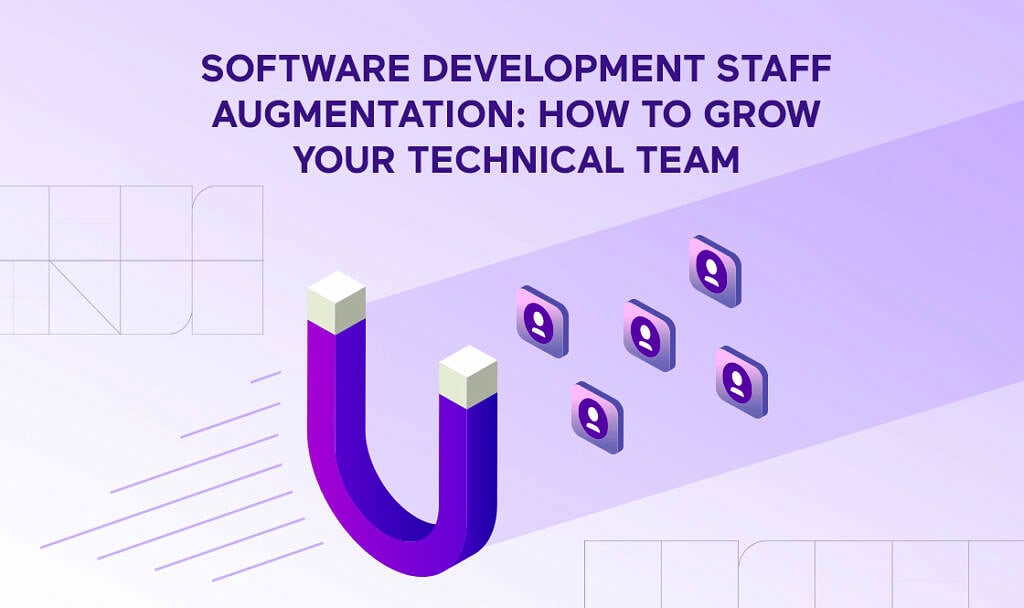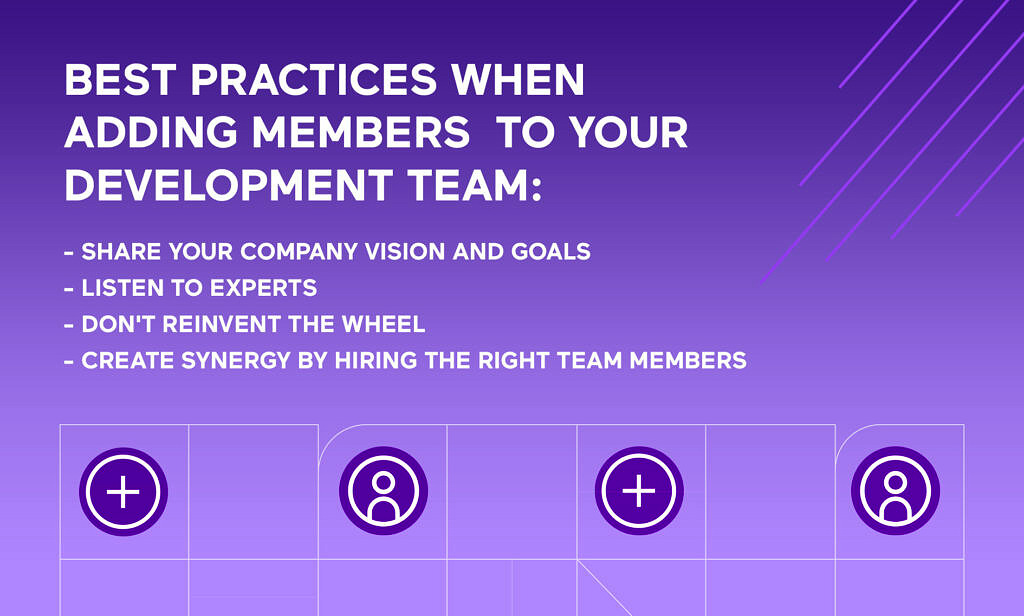When you’re in the business of helping companies with IT staff augmentation, you learn a thing or two about building up tech teams quickly and efficiently. Growing your software development team might seem easy — post the job online, conduct a few interviews, hire, and you’re done, right? Not quite.

Depending on your own technical know-how and the needs of your business, the type of developers for hire may vary. And when it comes to building software solutions that benefit your business, you need more than just a warm body in the office. You need someone who understands the vision of the product you want to build as well as someone who can mesh with your existing team and provide essential skillset and talents that may be missing.
What is IT Staff Augmentation?
Software development staff augmentation is a business strategy in which a company fills gaps in its internal development team by hiring external talent or resources temporarily. This approach allows organizations to scale their development capacity quickly and efficiently by leveraging external expertise to complement their existing team. Staff augmentation can involve hiring individual developers, designers, testers, or entire teams through outsourcing firms or freelancers to work alongside internal staff.
Many companies run into growing pains as they scale up their development team. Here’s what you need to know about software development staff augmentation to avoid costly hiring mistakes.
Why is Staff Augmentation Model So Popular in the IT Industry?
The popularity of IT staff augmentation stems from its streamlined hiring process, especially due to the massive size of the software market. The flexibility offered by staff augmentation models aligns well with the dynamic hiring demands of today’s IT businesses. As reported by BusinessWire, the IT outsourcing market is expected to reach nearly $1.493 billion in revenue by 2025, reflecting an impressive 11% annual growth rate. This rapid growth necessitates a readily available pool of skilled specialists, facilitated by resource and staff augmentation that aids in distributing tech talents across various businesses.
In contrast to traditional in-house hiring, which involves multi-step processes like candidate screening, background checks, payroll setup, and onboarding, staff augmentation offers expediency. Reputable outsourcing vendors manage these aspects, carefully selecting qualified and experienced developers based on specific project requirements. This streamlines the selection process, allowing executives or hiring managers to focus solely on interviewing and onboarding the best candidates for their project needs.
When Software Development Staff Augmentation Can Be Your Ideal Solution
- Is your in-house team struggling under a heavy workload? Perhaps you lack the specific talent required to launch a new project. IT staff augmentation can provide the skills and expertise needed to bridge the gap, allowing your existing team to maintain their focus without compromising on the new project.
- Staff turnover is inevitable in any organization. Software development staff augmentation offers a flexible solution to fill temporary vacancies arising from maternity leave, illness, or other planned or unplanned absences, ensuring projects stay on track without significant disruptions.
- Certain projects might require specialized skills that your current team lacks. Technology staff augmentation can provide access to highly skilled professionals with the specific expertise needed to complete the project, eliminating the need for permanent recruitment and associated costs after project completion.
- Staff augmentation is a client-managed model, meaning you hold the responsibility for overseeing the work of the augmented team. This approach is ideal if you have a CTO, project manager, or technical expertise within your team to effectively manage the project delivery and ensure smooth collaboration.
- Finding top talent, especially senior developers or those with rare skills, can be a lengthy and competitive process. Staff augmentation allows you to partner with a company that possesses a wider talent pool of qualified professionals, enabling you to quickly scale up your team and expedite project progress.
Scaling Software Development Teams: Hiring and Outsourcing and Outstaffing, Oh My!
There are three proven ways to expand your technical team. Understanding the pros and cons of each can help you decide which method can solve your current challenges most cost-effectively:
Hiring an In-House Team
While hiring full-time employees to add to your tech staff may seem an obvious solution, it also comes with some operational challenges.
In-House Team Pros
- You can assure long-term cooperation and don’t have to worry about company secrets being leaked through third-party employees.
- It gives you access to a dedicated and consistent team of talents that can respond to business needs quickly.
- Team members have institutional knowledge about the business so there’s minimal ramp-up time when starting a new initiative.
In-House Team Cons
- You have to account for the time and costs associated with recruiting, hiring, managing, firing (less flexibility), benefits, training, etc.
- You need to hire support staff to manage administrative tasks, such as payroll, benefits, etc., which adds to the operational overhead.
- You incur more office space costs.
- The long hiring process may not allow you to respond to immediate needs.
Key takeaway: When considering the traditional hiring model, you want to balance the security of taking on a new long-term employee who is fully integrated into the company with the time and dollar resources required to recruit, add to payroll, and cover overhead and benefits commonly associated with a new hire.
Staff Augmentation vs Outsourcing
When you outsource design or software development project, you’re transferring a whole line of business or project to another company. You don’t necessarily have control over who is doing what, only that the work is getting done.
Outsourcing Pros
- It can be more cost-effective, especially for one-time tasks or projects.
- You can find a freelancer or contractor relatively quickly to fill immediate needs.
- You don’t need all the internal competencies to manage a large team.
- You can target the exact skill sets you need immediately.
Outsourcing Cons
- Time zone, location differences, and language barriers can make collaboration more challenging.
- You still have to manage payments made to each outsourced team member or agency.
- You don’t have complete control over the quality of the solutions. Low-quality deliverables may require rework and lead to delays.
- The total cost may be higher than hiring an in-house team.
Key takeaway: For a long time, outsourcing got a bad wrap. In the 21st century, however, as more pools of high-quality tech talent develop around the world, outsourcing has become more mainstream for companies looking to expand their development departments quickly. Working via an outsourcing agency may provide more security than hiring a solo freelancer; however, the outsourcing option does offer key cost savings.
Outstaffing/IT Staff Augmentation
Staff augmentation uses temporary external specialists to grow the capacity of a department or entire organization. This outsourcing strategy implies external contractors or an agency is hired to fill expertise holes or tech stack gaps to build or support ongoing projects.
Choose software development staff augmentation services if you need:
- to scale up or down quickly, using IT staff augmentation providers
- to deliver a project on time – and without any delays
- a specific technical skill set
- require an experienced and specialist IT team to improve your overall solution delivery
- don’t want to hire a full-time employee
- don’t have an HR team to recruit and hire an employee
- don’t want to offer benefits to the person or agency and just want to pay a weekly or monthly cost
- get vetted candidates put in front of you quickly
- can easily change a candidate that isn’t working out
- can leverage other areas of IT staff augmentation company in terms of their expertise and experience from other team members
Outstaffing Pros
- It’s a cost-effective solution because you only have to deal with one outstaffing company, which will coordinate finding, recruiting, and hiring all the team members for you.
- You don’t have to worry about managing payroll, taxes, benefits, time-off, etc.
- You have the flexibility to adjust the number of technical specialists on your team, depending on the number and nature of projects you have at any given moment.
Outstaffing Cons
- You may still need to engage on some level with the employees’ day-to-day activities, either yourself or via a staff member who can handle project management and resource management if the agency doesn’t do that for you.
- In some cases, the external employees may rotate (e.g., during holidays), and you’ll have to spend time and resources on onboarding the replacements.
- The total cost could be higher than hiring an in-house team.
As a practice of having third-party dedicated team members work directly for your company, you manage the employees directly and have complete control over how they work. Meanwhile, the outstaffing company will handle payroll, hiring, firing, benefits, etc.
Key takeaway: Outstaffing feels like the best of both worlds, where the control you get with hiring meets the flexibility and cost-effectiveness of outsourcing. Spiral Scout has successfully oustaffed multiple companies with distributed technical teams that serve them for years, helping to design and develop new software products as well as refactor and maintain existing ones.
Staff Augmentation vs Managed Services
Software development staff augmentation tackles resource gaps by providing businesses with temporary or permanent tech staff to complete specific projects or fill specialized skill needs within their existing teams. In contrast, managed services involve transferring the complete responsibility and management of a specific function or process to a dedicated external provider.
This model allows businesses to concentrate on their core competencies while the managed service provider (MSP) handles a range of critical tasks, often encompassing:
- Cloud infrastructure maintenance: Ensuring optimal performance, security, and scalability of cloud-based environments.
- Security: Implementing and managing comprehensive security solutions to protect against cyber threats.
- Backup and recovery: Establishing robust systems for data backup and disaster recovery, minimizing downtime and data loss.
- Platform migration: Assisting with the seamless transition of applications and data to new platforms, ensuring minimal disruption.
Managed IT Services Pros:
- Enhanced Focus: Organizations can free up valuable resources and internal expertise, allowing them to dedicate their efforts towards core business activities and strategic growth.
- Cost Optimization: Managed services can offer cost-effectiveness by leveraging the provider’s expertise and economies of scale.
- Improved Efficiency: Utilizing experienced MSPs can lead to increased operational efficiency and streamlined processes.
Managed IT Services Cons:
- Potential Lack of Personalization: While managed service providers (MSPs) offer scalable solutions, they might not always cater to highly customized needs or integrate seamlessly with existing, unique systems.
- Primarily Remote Support: Typically, managed IT services operate remotely, limiting on-site support for troubleshooting issues in person.
- Limited Software Coverage: If you require support for software falling outside their purview, the MSP might be unable to assist, potentially requiring you to seek additional solutions.
7 Common Reasons You May Need Software Development Staff Augmentation
Understanding the importance of building a software development team will help identify the best solution to meet your business objectives. Here are some common reasons that an organization needs software development staff augmentation to add to its development team and support business growth:
- Your agency has increased visibility, and the current team doesn’t have the capacity to handle the volume of incoming projects from new and existing clients. In some cases, some clients may be waiting too long for deliverables and you risk losing business if you don’t turn around projects faster.
- Your startup has a great idea for an MVP (minimum viable product), prototype, or first-round software product. You have secured funding and now need to hire technical talents to help your team build it.
- You have a defunct engineering team or team member that needs to be replaced.
- Your business is experiencing rapid expansion and needs the right team augmentation to support its growth. For example, you may need to expand an existing team to ramp up development for additional core and non-core projects.
- You need to fill a critical technical skills gap(s) in executing highly-specialized projects that may not be within the core competency of your current tech team (e.g., developing a mobile app).
- You need more coverage in specific areas within the development process, such as quality assurance and software testing services.
- Your operation is expanding, and ad hoc processes are impacting cost-efficiency. You need to hire business analysts and project managers to streamline workflows, create product documentation, and ensure that deliverables are on track.
Best Practices When Adding Members to Your Development Team

Adding a new member to your technical team or outsourcing development project can be a significant investment, and you want to make sure it’s paying off. Follow these steps to optimize your ROI:
Share Your Company Vision and Goals
It’s one thing to share what you want a developer to build for you. It’s a whole other thing to explain why you want them to build it and what it means for your business strategy and growth. When you onboard new recruits, whether they are full-time hires or outstaffed workers, empower them to take initiative by clearly communicating your company’s vision and values. By making sure they have a good grasp of your business objectives and feel like a part of the team, you also sell them on your future goals and generate excitement
Note: Be realistic about what can be achieved within a certain timeline and budget. If you’re sharing an impractical idea, it may be harder to attract and retain the best talent. Great software developers tend to look for opportunities that have the best chances of succeeding and look good in their portfolio or resume.
Listen to Experts
Adding team members isn’t just about increasing headcount. If you don’t know exactly what you need on the technical side of things, then find experts who can help you. Tap into your professional network, ask friends with technical backgrounds, and consult your existing team members about the best way to achieve your business goals (the HOW) and find the right technical people to turn your vision into reality.
In development, the process often follows that the leadership/owner will establish a vision and formulate a strategy (e.g., WHERE is our business going? WHY?). Then the management team will determine WHAT needs to be done to achieve the vision. And finally, development teams will take the reins on HOW to implement (and WHO will implement) the strategy and meet the business objectives.
Don’t Reinvent the Wheel
Find employees or outsourcing and outstaffing agencies who have done before what you want to achieve now and see how they structure their teams. Make sure to ask them about past projects and work related to the challenge you are giving them. This is particularly important if you’re not technically inclined because there are many pitfalls you may not even be aware of. Reach out to a friend or colleague with the right knowledge and experience for support and do your due diligence to explore all the options.
Create Synergy by Hiring the Right Team Members
The right team dynamics enhance collaboration and create synergies that foster innovation. You need to break the status quo by adding team members of various ages, cultures, genders, and backgrounds to introduce different input and transformative perspectives.
In addition, look for developers who are eager to learn and prioritize training and education. Their willingness to grow and advance their skill set will benefit your product development and business growth in the long run.
IT Staff Augmentation Contract: What To Expect?
The growing demand for specialized IT skills, coupled with the need for agility and cost-effectiveness, has propelled IT staff augmentation to the forefront of modern business strategies. This model allows organizations to plug skill gaps and augment existing teams with qualified personnel, fostering project completion and innovation. However, entering into a successful IT staff augmentation contract requires careful consideration of several key elements.
What is a Staff Augmentation Contract?
A staff augmentation contract is a legal agreement between an organization (client) and a staffing provider that outlines the terms and conditions for providing temporary or permanent IT personnel to supplement the client’s existing team. This contract serves to formally establish the scope of work, the responsibilities of each party, and key aspects like payment, intellectual property ownership, and termination clauses.
Key Elements of IT Staff Augmentation Contract
Scope of Work:
A clearly defined scope of work forms the cornerstone of any IT staff augmentation contract. This document should meticulously outline the specific project requirements, deliverables, and timelines. Furthermore, it should detail the roles and responsibilities of both the client organization and the staffing provider.
Selection and Onboarding:
The contract should establish a clear selection process for identifying qualified personnel. This typically involves outlining the desired skillsets, experience level, and interview procedures. Additionally, the agreement should address the onboarding process, including procedures for background checks, security clearances, and integration into the client’s work environment.
Billing and Payment Terms:
Transparent billing and payment terms are crucial for avoiding future disputes. The contract should specify payment methods, billing cycles, and any applicable fees associated with the service. Additionally, it should outline the procedures for overtime compensation, travel expenses, and any potential adjustments to the scope of work.
Intellectual Property (IP) Ownership:
Ownership of intellectual property (IP) created during the augmentation period needs to be explicitly addressed in the contract. This includes establishing clear ownership of any software code, documentation, or other intellectual assets developed by the augmented staff.
Termination Clause:
A well-defined termination clause protects both parties and facilitates a smooth exit strategy if necessary. This clause should outline the grounds for termination, the notice period required, and any associated costs or penalties.
Dispute Resolution:
Establishing a dispute resolution mechanism ensures a fair and efficient process for resolving any disagreements that may arise during the contract period. This could involve mediation, arbitration, or litigation, depending on the agreement between both parties.
Service Level Agreements (SLAs):
For critical projects, incorporating service level agreements (SLAs) within the contract can provide additional assurance. SLAs establish specific performance metrics and response times for the provided services, ensuring accountability and transparency.
Where can you find those ideal solutions for seamlessly augmenting your team to drive product development?
For inspiration, let’s delve into some compelling examples of integrating IT staff augmentation services into the software development process.
Loop Golf: Mobile App Development to Innovate the Golfing Experience

Loop Golf is dedicated to redefining the golfing experience for enthusiasts and professionals alike. Founded by a passionate sports amateur, the company’s mission is to provide a seamless and enjoyable platform for golf lovers to improve their game and play more golf.
Challenge: Charting New Territory and Managing Data
- Apple Watch Development: This was new territory for the team, requiring a blend of innovation and precision to ensure a seamless user experience.
- Managing Data: Utilizing location tracking to improve service quality resulted in generating much data, which needed a fresh approach to maintain good performance.
Solution: Efficient Tech Team Augmentation Strategy
Spiral Scout’s strategic approach was built on practical and efficient team augmentation. We deployed our most seasoned developers to seamlessly integrate into LoopGolf’s team and processes. This collaboration allowed LoopGolf to maintain control over their core technologies and methodologies while benefiting from our specialized skills where they were needed the most.
Transformative Outcomes and Innovative Solutions
Our solution stands out as a distinctive product in the aggregator landscape, exceeding even their oldest competitors in the market.
The Results? Our collaboration with LoopGolf Co. unlocked innovation in several ways:
- Strategic IT Staffing: Our approach to tech team augmentation allowed LoopGolf to maintain control over their core technologies and project direction while benefiting from skillset alignment where it mattered most.
- Innovative Solutions: We pushed boundaries and embraced innovation. The integration of live-streaming capabilities into LoopGolf’s platform set them apart and offered a unique selling point to users.
- Dynamic Development: Our tech team fostered an environment where creativity thrived. Throughout the project, we encouraged the emergence of innovative concepts, ensuring that LoopGolf’s platform continually adapted to meet evolving user needs.
Transforming Growth into Opportunity: How Inturn Leveraged Spiral Scout’s Expertise

Inturn, a unique platform connecting a network of buyers, faced significant challenges as it evolved from a startup to an enterprise. The rapid transformation created operational bottlenecks, mounting technical debt, and a shortage of skilled resources.
Challenge: Navigating the Transformation from Startup to Enterprise
Inturn was operating under the assumption that they were still in the startup phase, unaware of their transition to an enterprise. This unexpected growth led to operational complexities, technical debt accumulation, and an overwhelming workload for their existing team. The goal was to achieve scalability, maintainability, and the ability to serve their expanding user base effectively.
Solution: Implementing IT Staff Augmentation
IT staff augmentation process was centered around assembling a highly skilled tech team that could comprehensively address Inturn’s needs. To kickstart development and build a 10-member team of Golang and PHP engineers promptly and formed a 5-member Automation QA team to implement an automation testing framework.
Empowering Inturn Through Tech Integration: The Results of Augmented IT Staff
By staffing the development project with senior engineers who possessed a deep understanding of Golang and PHP, we ensured that Inturn received proactive recommendations for architectural solutions and technical approaches. Our top tech talent didn’t just execute tasks; they became integral contributors, offering valuable insights to steer the project toward success. As a result, Inturn achieved a significant milestone – they successfully onboarded several Fortune 500 retailers onto their platform.
Key Takeaways and Future-Proofing Your Product
The integration of our expert tech team reshaped Inturn’s technical landscape, addressing immediate challenges and future-proofing their technology for continued growth. Spiral Scout’s commitment to excellence and technical expertise made a lasting impact, enabling Inturn to thrive in a rapidly evolving digital landscape.
How to Set Up a New Dev Team Member for Success
After you have found your top tech talent, the job isn’t done yet. Make sure they (and you) are set up for success by:
- Communicating roles and responsibilities clearly to set the right expectations.
- Establishing communication practices, providing the right project management and collaboration tools (e.g., Jira, Asana, Slack, etc.), and fostering a collaborative environment.
- Setting measurable goals, milestones, and expectations for various tasks and activities through regular meetings, messaging tools, and project management platforms.
- Reinforcing the company’s vision and culture by walking your talk. Also, encourage team-building activities and make sure both on-site and remote team members are equally involved.
- Empowering team members with trust and autonomy. Let them do their job and don’t get in their way!
FAQ
1. How does staff augmentation work?
IT staff augmentation involves hiring external IT professionals to temporarily join your existing team. This fills skill gaps for specific projects or addresses workload surges
2. What is the difference between staff augmentation and staffing?
While both involve acquiring external talent, staffing acts like an outsourced team, managed by the agency, often for longer projects. In contrast, software development staff augmentation
involves outsourcing highly skilled experts to fill specific roles or projects for a predetermined amount of time
3. When should you choose IT staff augmentation services?
Consider IT staff augmentation services when you need:
- Short-term or temporary help: Ideal for project bursts, seasonal demands, or staff vacations.
- Specialized skills: Fill specific skill gaps your team lacks for specific projects.
- Cost-effectiveness: Avoid full-time employee expenses for temporary needs.
- Faster project completion: Quickly access skilled professionals to expedite projects.
4. What benefits does software staff augmentation offer?
Tech staff augmentation offers a unique combination of flexibility and efficiency for IT projects. Your team size can be easily adapted to specific needs, scaling up or down as required. This translates to cost savings, as you only pay for the hours worked and avoid full-time employee expenses like benefits and overhead.
Additionally, staff augmentation grants access to a wider pool of skilled professionals than your local market might offer, allowing you to find the perfect tech talent for specific tasks. This can significantly accelerate project completion times and reduce associated risks.
How Spiral Scout Can Be Your Potential Software Development Staff Augmentation Partner?
Businesses are undergoing intense digital transformation and implementing new technologies at a rapid rate to stay relevant and competitive. In fact, according to one survey, 70% of companies have (or plan to have) a digital transformation strategy, 60% of enterprises believe that IoT will play an important role in their businesses, and 68% of organizations believe that the future of business will involve the collaboration between people and Artificial Intelligence.
To properly execute a digital transformation initiative, from cloud computing and business process automation to artificial intelligence and IoT, organizations need to have the right technical team in place, and building that team is not the easiest thing to do whether you’re going to choose software outsourcing and outstaffing and to get the most profit from nearshoring advantages or hiring an in-house development team.
Software development staff augmentation has moved significantly beyond its inception phase. It is an ideal option for those companies that are looking for quick access to the latest technologies, reducing expenses on staff recruitment, as well as speeding up this process, making it faster and with minimum effort. Thus, getting more productive results, companies benefit from this flexible model of staffing.
In the fast-paced, highly competitive business environment cooperating with a reliable staffing partner that has resources in your key markets simplifies the process. Spiral Scout offers you the possibility to grow your software development team with all the benefits and less of the headaches and overhead.
Whether you decide to hire a development team to meet ongoing demands, hire individual contractors to fill immediate needs, or hire IT staff augmentation company to streamline operations, you need to look for team members with the right expertise to develop your products and meet your business objectives.
Contact us today to hear how we can help your business assemble a tech team of highly-skilled software developers or software engineers. Our technical and recruitment experts will work with you and ensure strict adherence to your specific needs and goals as a company. Don’t just take our word for it — check out our reviews on Clutch and GoodFirms to see what our clients have to say about our services.





